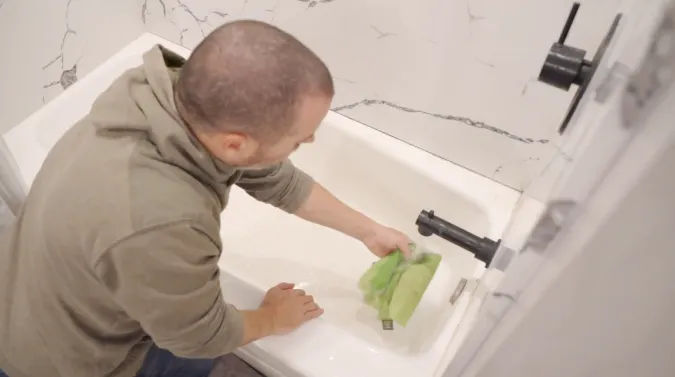Last Updated on September 7, 2023
When the filth starts to take over your tub, you don’t need to panic. There are a multitude of clever and efficient tricks you can use to get that pesky non-slip tub bottom sparkling.
For instance, combining hydrogen peroxide with baking soda is an incredibly efficacious approach. Combine dish soap, liquid detergent, and lemon/citric acid solutions to get the same effect.
If all else fails, there’s always the good old-fashioned way. Power scrubbing it clean with some vinegar mixed in for extra punch or even highly specialized commercial cleaners if necessary.
Let’s explore these methods step-by-step so you finally beat the filth in one epic showdown, which would totally be worth celebrating afterward.
How to Clean Non Slip Tub Bottom: Different Methods
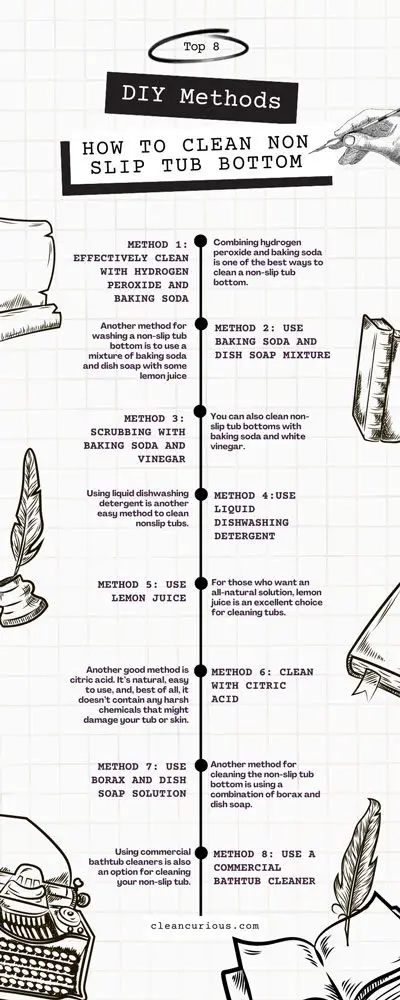
Ready to make your tub sparkle? Check out these tried-and-true tips for bringing that slippery floor back to life.
Method 1: Effectively Clean With Hydrogen Peroxide and Baking Soda
Combining hydrogen peroxide and baking soda is one of the best ways to clean a non-slip tub bottom. You’ll need equal parts hydrogen peroxide and baking soda to make a paste.
Once this is done, wet the surface of the non-slip tub bottom with water and then rub the paste onto it. After that, let it sit for 30 minutes to an hour. Then wipe and rinse with warm water.
The hydrogen peroxide helps to disinfect, while the baking soda works as an abrasive to help remove filth from the surface. This process can be repeated as often as needed depending on how dirty the surface is.
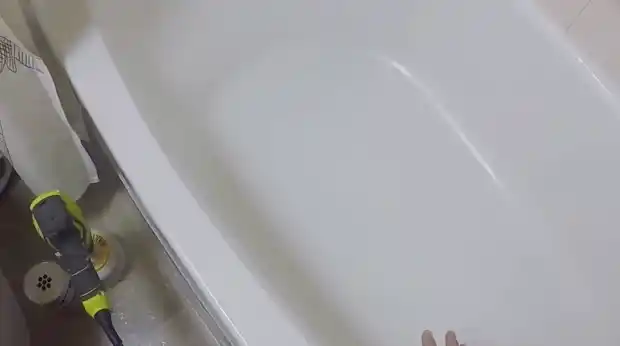
Method 2: Use Baking Soda and Dish Soap Mixture
Another method for washing a non-slip tub bottom is to use a mixture of baking soda and dish soap with some lemon juice added in for an extra boost of cleaning power.
For starters, mix together equal parts of baking soda dish soap and lemon juice until it forms a foamy texture. Then, wet the tub’s surface with some water before applying the solution using a sponge.
Let it sit for around 30 minutes to work its magic. In the end, rub down the surface with a wet sponge and rinse off any remaining residue with clean water.
Method 3: Scrubbing With Baking Soda and Vinegar
You can also clean non-slip tub bottoms with baking soda and white vinegar. All you need to do is mix equal parts of both ingredients together until they form a thick paste.
Spread that on your trouble spot, and give it around 5 minutes worth of scrubbing with either a brush or sponge. Then let it sit for 15-20 before rinsing it off with mild hot water. If grime still persists after one go-round, simply repeat as needed.
Method 4: Use Liquid Dishwashing Detergent
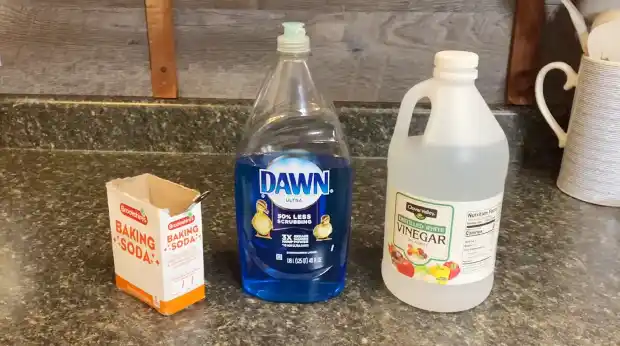
Using liquid dishwashing detergent is another easy method to clean nonslip tubs. Simply apply some liquid dish soap onto the surface of your refinished tub to clean.
Add some water and scrub it together using a sponge or brush. This will create a nice soapy solution that will help lift away dirt and grime from the surface.
Let it sit for 10-15 minutes before rinsing off with clean water. Repeat this process if necessary.
Method 5: Use Lemon Juice
For those who want an all-natural solution, lemon juice is an excellent choice for cleaning tubs. Start by squeezing lemon juice over the entire surface of your tub.
Be sure to cover everything evenly. Let the lemon juice soak for 10-15 minutes, then grab a brush and scrub down any remaining filth from the surface. When finished, rinse off with warm water.
Method 6: Clean with Citric Acid
Another good method is citric acid. It’s natural, easy to use, and, best of all, it doesn’t contain any harsh chemicals that might damage your tub or skin.

To start, you will need to mix citric acid with water to create a paste. Once that’s done, simply apply the paste evenly over the surface and wait 10-15 minutes. This allows the citric acid to penetrate deep into the nooks and crannies of your tub and loosen up any dirt or grime.
After this time, take a soft brush and scrub away all of the excess residues. Lastly, rinse thoroughly with clean water to neutralize the chemical reaction that was created by using citric acid and make sure there are no remnants left behind.
Method 7: Use Borax and Dish Soap Solution
Another method for cleaning the non-slip tub bottom is using a combination of borax and dish soap. Start by mixing together one part of borax with three parts of water until it forms a thick paste.
Add in some dish soap to give it some extra cleaning power. About one tablespoon should do the trick.
Apply this solution evenly onto the surface of your tub and let it sit for about 15 minutes so that it can really get into those stubborn areas where dirt has been hiding away.
After this time has elapsed, take a sponge or soft cloth and gently scrub away any residue that has been left behind. When you’re done, rinse it clean.
Method 8: Use a Commercial Bathtub Cleaner

Using commercial bathtub cleaners is also an option for cleaning your non-slip tub. But, these products often contain harsh chemicals that can damage if not used properly, so always read the instructions carefully before applying them to any surfaces.
When shopping for the best bathtub cleaner, always check the ingredients list. Stay away from anything too harsh. And don’t worry about spending hours scrubbing:
Most commercial cleaners come in either liquid or wipe form. Simply grab a cloth and get wiping until you have that fresh shine. Then just rinse off any leftovers with clean water, easy peasy.
Can You Use Chlorine for Cleaning Non-Slip Tub Bottom?
It’s not a good idea to use chlorine to wash non-slip tub bottoms. Chlorine is a strong chemical and can discolor the surface of the tub bottom if used on it as well as cause damage to the material over time.
Rather than using chlorine, try other alternatives like baking soda and vinegar or milder detergents we discussed above. Baking soda and vinegar are much gentler on surfaces than chlorine but still effective in removing dirt and grime from non-slip tub bottoms.

You can also use a mixture of warm water and dish soap to clean any remaining dirt or grime off of the tub bottom without having to worry about damaging the surface or discoloring it. So save yourself from future cleaning headaches by choosing one of these milder yet dependable options.
Does a Magic Eraser Work For Cleaning Non-Slip Tub Bottoms?
A magic eraser can work wonders when cleaning non-slip tub bottoms. The melamine foam in the eraser is incredibly dense and abrasive, meaning it can cut through the filth on the surface.
Simply wet the Magic Eraser and rub it onto the surface, covering all areas. You may need to press down more firmly while rubbing with the eraser for heavily soiled surfaces.
Allow the eraser to sit on the surface for a few minutes, and then rinse it off with clean water. You may want to repeat this process a few times if necessary, as it can be pretty effective in removing stubborn dirt or soap scum buildup.
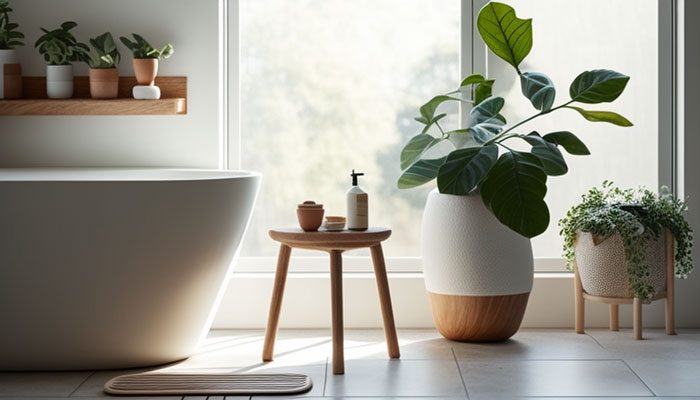
For extra cleaning power, add a mild cleaning solution or vinegar to your Magic Eraser before using it on your tub bottom. This may help break up any tough deposits that have accumulated over time.
Just be sure not to use anything too abrasive, as this could damage the non-slip material on your tub bottom and cause discoloration or fading.
After each scrubbing session, make sure to rinse off the tub bottom with clean water and wipe away any suds or residue that may remain.
Is It Okay to Use Ammonia to Clean Non-Slip Tub Bottoms?
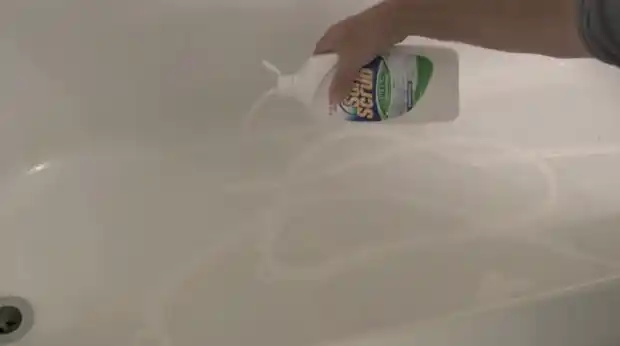
You can clean non-slip bathtub bottoms with ammonia. However, you need to be careful and use the right amount so that you don’t damage the surface of your tub. Here’s how to do it:
First, mix 1 part ammonia with 10 parts water in a bucket. Put on protective gloves and goggles before starting. If you want, you can also open a window or door for ventilation.
Next, dip a sponge or cloth into the mixture and scrub the non-slip surface of your tub. Be sure to get into all the crevices and grooves of the texture. Pay special attention to any areas with stubborn stains or dirt buildup.
When finished, rinse your tub thoroughly with warm water until all traces of ammonia are gone from the surface. Make sure not to leave any residue behind, as this could cause damage over time.
Lastly, dry your tub completely with a soft towel before using it again. This will help prevent any remaining moisture from damaging or discoloring your tub over time.
Using ammonia properly is an effective way to clean non-slip surfaces without harming them in the process. Just remember to use proper safety precautions and always ensure that there is no residue left behind after cleaning.
Get Your Non-Slip Bathtub Gleaming Again
With the various methods of cleaning a non-slip tub bottom discussed in this blog post, it is clear that there is no shortage of options available.
From simple solutions like hydrogen peroxide and baking soda to more complex ones like citric acid or Borax and dish soap solutions, you’ve got plenty to choose from when cleaning your non-slip tub bottom.
Whatever method you choose to go with, make sure to follow the instructions accordingly for the best results.

